 Review Article
Review Article
The Violation of the Environment and Agriculture Will Create a Serious Global Problem to Humanity. Only the Sciences Can Offer the Help Required
Stergios Tzortzios, Professor, University of Thessaly, Greece.
Received Date:July 17, 2023; Published Date: July 27, 2023
Abstract
Many are the times we hear in scientific speeches (in meetings-conferences) and in announcements from Organizations about the exceptionable effect of the agriculture to the pollution of the environment and the peoples’ health by the unreasonable use of pesticides and other chemicals in the farming with the terrible consequences to the increase of neoplasia’s (cancerous growths) and various other fatal diseases. On the other hand, the effect of the environment to agriculture is rather unacceptable when are ascertained cases of plant and animal production that lasted to the people food in areas terribly polluted by drills of the industrial factories, the rinsing thrown by the cities and various other unacceptable environmental factors. If in the meaning of the “environment” we include and the effect of the climate change with the terrible phenomena in the rural and urban areas, one can realize the dimension of the whole problem. The people stay dumb founded and anxious in front of this very serious phenomenon and ask for explanations and for the solutions required. It is to mention that this mutual effect has the resulting implications for internal and international migration and the general human life. The phenomenon is in a great extent created by the man and the man has the proper responsibility to find and give the solutions. In this study an effort is undertaken to present the scientific society’s effort in the various countries to search the problem, in order to offer the information required to the world decision makers.
Keywords: Environment and agriculture; A global problem; Climate change; Hazardous diseases; Migration
Introduction
It is very well known that the last years the environment’s hooplas to the mankind become more and more evident for the strong need of the special care it requires, in order avoiding the catastrophe that can lead to the revenge that nobody would desire. It is well known the efforts undertaken by men in world forums (Kioto, etc.) in order to try understanding the needs for the environment’s care, the failure of which suggested the known peoples’ demonstrations in the entire world with the exclamations of their anguish.
From the other side, referring to the implications of agriculture, questions arise of the type: as if agriculture from the sense of car ing the land we reached the sense of destroying it. Such questions leaded the special study of many researches that go back to many and painful mistakes. The maximalistic aim of the conventional agriculture for the most intensive production leaded the agricultural research to the study of the effectiveness of always more increasing inputs, ignoring (or at least without the proper care) for what is going beyond the production. For the targets of the higher possible production many and various fertilizers and huge amounts of weed killers, insecticides, fungicides, and new forms of mutant genetic material, enter the production process on the purpose of the highest possible profit. Green and animal houses derive undesirable emissions which affect badly the environment as it is shown in the following (Figure 1).
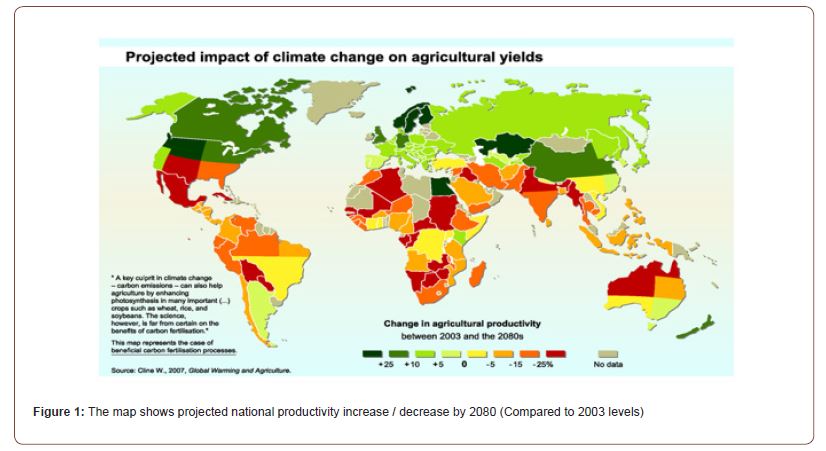
General Discussion
Agriculture from the aspect of a general interest consists in a sector of the production industry, while from the aspect of individual interest it refers to the agricultural enterprise- and this is what seems to present its guiltiness, at least in a percentage-of the deterioration of the environment the last years.
Environment, on the other hand, is the self-explanatory concept of the complex system of the stable, watermark and aerial space, in which the man lives and activates (together with all the other alive organisms) in various activities between which is and that of the agricultural production, under the basic assumption that these activities would be under his control, in order to ensure the natural equilibrium in the environment. However, the question is, if this assumption could be kept up today, and if not, which are the sequences of whatever imbalance in the products of the agricultural production, which, of course, comprise the basic element of the man’s survival.
That is to say, it seems that there is a certain interaction and interdependence between Agriculture and Environment. It could be right the Environment to protest to Agriculture for its possible interferences, as, the same, and Agriculture from its side to the Environment. It is not to ignore that this entire situation is caused by the man and it can be corrected by the man also. The London River Thames is probably the best example of the man’s achievements after proper studies and actions, as it has been changed from that terrible polluting source to a place of various London activities.
It is rather not purposeful to approach the subject in a deep scientific way, because our questionings would require a forum of all the scientific specialties, for an effort to explain the multi-factorial matter from all the points of view. If only we remember the certain aspect expressed by experienced geneticists’ scientists [1], who reported that “each genotype in another environment is other genotype” we may wonder to where is to go the creatures evolution, that Darwin taught us, as the environment becomes so complex and different on and on. Let’s stay so in a simpler commentary approach, asking for the help required for it from the main sciences-Agriculture and Environment- created by the mankind to serve these two fields in discussion.
The following figures show a comparison in the research undertaken by the developed and developing countries on the scientific fields of Agriculture and Environment the period 1996-2013.
(It is interesting to remind that the specializations included in the general fields of agriculture and environment are presented in the following lists, as they are grouped in the international journals [2].
Agricultural and Biological Science
Agricultural and Biological Sciences (miscellaneous), Agronomy and Crop Science, Animal Science and Zoology, Aquatic Science, Ecology, Evolution, Behavior and Systematics, Food Science, Forestry, Horticulture, Insect Science, Weed control, Plant protection, Plant pathology, Plant Science, Soil Science, Agricultural management and marketing, Agricultural Economics.
Environmental Science
Ecological Modeling, Ecology, Environmental Chemistry, Environmental Engineering, Environmental Science (miscellaneous), Global and Planetary Change, Health, Toxicology and Mutagenesis, Management, Monitoring, Policy and Law, Nature and Landscape Conservation, Pollution, Waste Management and Disposal, Water Science and Technology).
(Figures A1, A2, A3) show the comparison between the developed and developing countries for the research published in the field of Agriculture, and (Figures E1, E2, E3) the same comparison in the field of Environmental sciences as reported by [3].
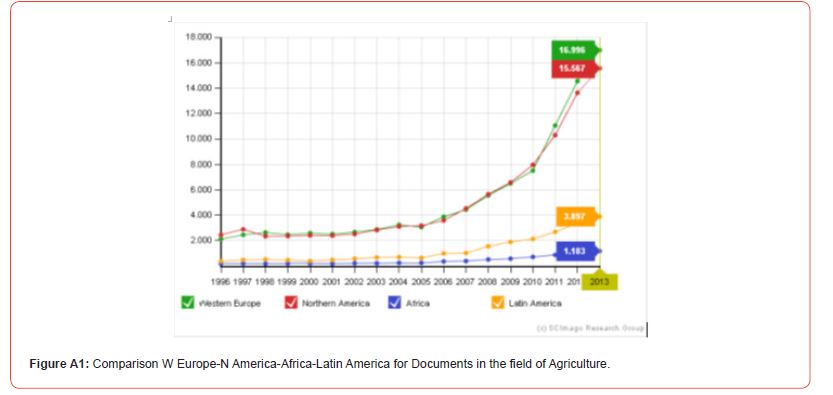

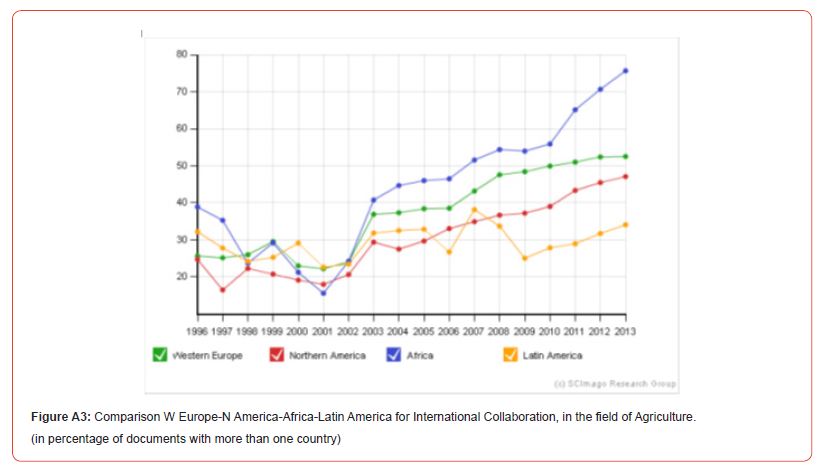
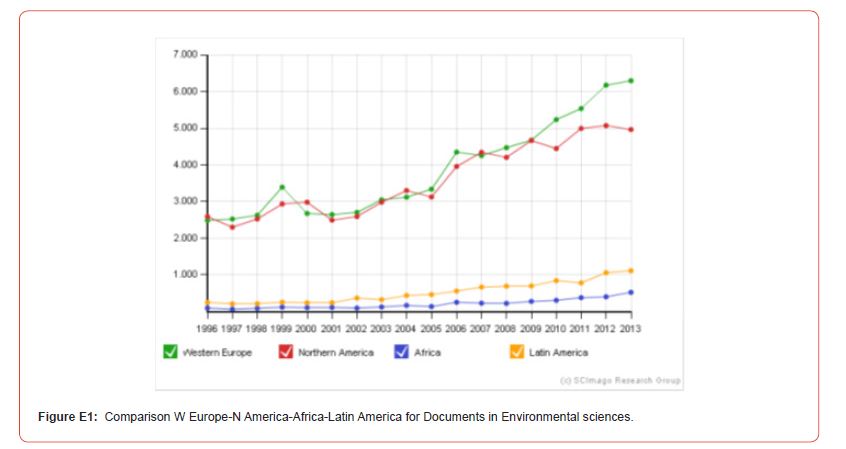
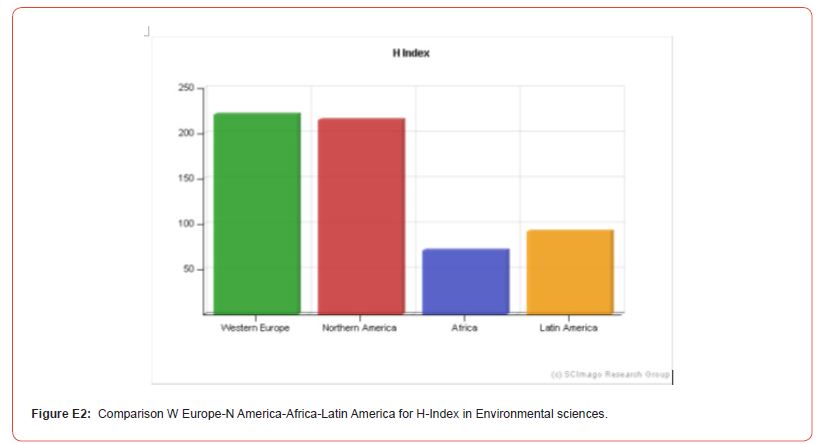
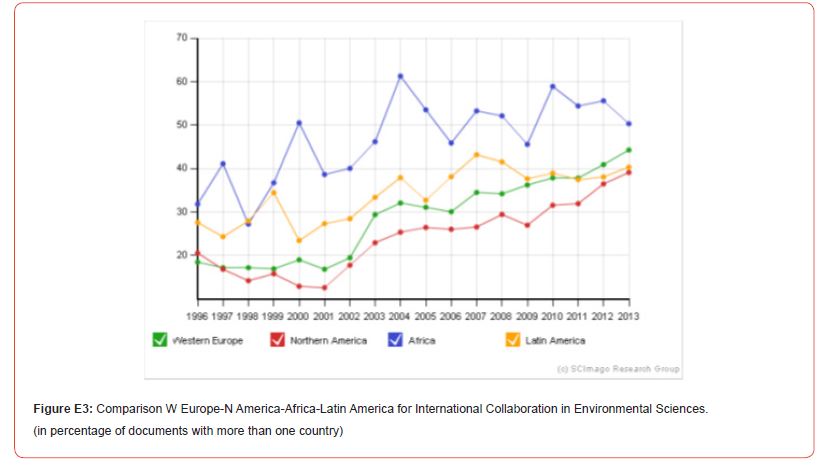
It is obvious the remarkable difference and the cooperation required from the developing countries for their global development.
The above figures show the great difference between the continents and more particularly between the developed and developing countries in the number of publications and their H-Index which means the quantity and the quality of their research. However, it can be emphasized that there is an increasing interest in the developing world for their collaboration with the developed countries in order to increase the quantity and quality of their biological research, as reported by [4].
It is very important to study very carefully the figures of the publications presented by the countries in order to:
a) Realize the effort undertaken by the scientific society.
b) Try to think about estimating the cost spent for all that research.
c) Ask for the “added value” generated by all that effort.
d) Ask also for the utilization applied to real practical applications, as they were the serious target of the organized research.
The vital importance of this serious attention to the publications derives from (among many other reasons) the fact that the agricultural sector in 2008 employed about 1.4 billion of the world’s 3.4 billion workers [5]. The number of undernourished people in the world has been on the rise since 2014, reaching an estimated 821 million in 2017 [6]. The global response to climate change today will determine how we feed future generations tomorrow. By transforming their agricultural sectors, countries have the chance to achieve food security for all. At the same time, agriculture, including forestry, fisheries and livestock production, generate around a fifth of the world’s greenhouse gas emissions. This must be reduced by 2030 to achieve the goal of limiting global warming to 2°C. It is to notice that the agricultural sector comprises the largest reservoir of workers in any economic sector looking for higher wages and more opportunity. Out-migration from the agricultural sector, particularly in developing countries, has been an ongoing phenomenon in recent years and is likely to continue into the future. Climate change, specifically global warming, is likely to compound the challenges faced by agricultural workers in finding sustainable livelihoods.
Discussion and Suggestions
It is very well known that the mankind is in a very anxious situation about the chain of environment - climate change – agriculture – migration -peoples’ health. Therefore, it is rather very reasonable to stay thinking in anguish about some very interesting relevant questions like the following: Why it is not possible to be achieved the so logical and desirable result in the peoples’ effort to find the solution in the problem of the proper equilibrium in the above phenomenon? Are the politicians able to conceive such multi-factorial phenomenon in its holistic form? The answer is certainly No, as it is so logical, for it is not possible for them to know, each one of the subjects involved in the entire phenomenon. There are only some isolated aspects expressed by some specific organizations, without any existence of a serious coordination of the entire complex. There are, certainly, the huge industries the interests of which are addressed to their private benefit, which, many times, are in a contrary to the aims of the proper equilibrium in the chain of environment- climate change-agriculture-peoples’ health. It is the time to realize that it is only the science that could offer the solution required, as it is the only foundation that possesses the real knowledge of the natural phenomena in their holistic form. However, if one goes through the specializations of each general field of science (e.g., the “agricultural and biological sciences”- as they are presented in the list of the publishing journals), it is easy to realize that some of them address their research (and the relevant education) mainly to a quantitative -productive and economic- goal, without the proper thought about the possible consequences deteriorating the environment. It seems that there is a need for a better coordination of the research within every institute and between all the similar institutes globally. To this purpose the new technologies offered by modern sciences such as the ICT and Biometrics could offer the help required in such multi-factorial phenomena globally.
Conclusion
As one can realize from what is presented above, the scientific societies- especially those in the developed countries, are doing their job in a rather very good responsibility. The question arises on what the respect is given to all that scientific effort by the governments and the various world political bodies. Another very serious remark deriving from the number of publications-especially from the remarkable difference in the quantity and quality of the research done is the necessity of a serious support and well organized collaboration between the developed and the under-developed countries. However, the general remark that can be done and the question arising refers to whether there is anybody who estimates- evaluates the total cost of the research. If the answer is yes, the serious question arises on what was the result of the practical utilization applied. Only the answers to such questionings could show the ambitious ways in approaching the solutions required.
Acknowledgement
None.
Conflict of Interest
The author declares there is no conflict of interest.
References
- Falconer SD (1989) Book. Introduction to quantitative genetics. Publisher: Burnt Mill, Harlow, Essex, England; Longman, Scientific & Technical; New York: Wiley.
- SJR (2015) Scimago Journal & Country Rank. Scimago Lab. Copyright 2007. USA: SJR.
- Tzortzios S (2018) The gap in the research on life sciences between the underdeveloped and developed countries and the help of the science of biometry in achieving the collaboration required. Biom Biostat Int J 7(2):125-129.
- Stergios Tzortzios (2015) The philosophy of biometry as a basic tool for the improvement of global biological research. JENRM, Commentary, 2(1).
- Philip Martin (2009) Climate Change, Agricultural Development, and Migration. GMF-The German Marshall Fund of the United States/ STRENGTHENING TRANSATLANTIC COOPERATION/ Climate Change and Migration.
- FAO-Food and Agriculture Organization (2018). Food Security & Nutrition around the Word/Hunger is on the rise. FAO, 2019.- Climate Change. FAO’s support to countries facing climate change. FAO 2018. ISBN 978-92-5-130571-3.
-
Stergios Tzortzios*. The Violation of the Environment and Agriculture Will Create a Serious Global Problem to Humanity. Only the Sciences Can Offer the Help Required. Sci J Research & Rev. 3(5): 2023. SJRR.MS.ID.000573.
Insecticides, Fungicides, Miscellaneous, Agronomy, Crop Science, Animal Science
-

This work is licensed under a Creative Commons Attribution-NonCommercial 4.0 International License.






